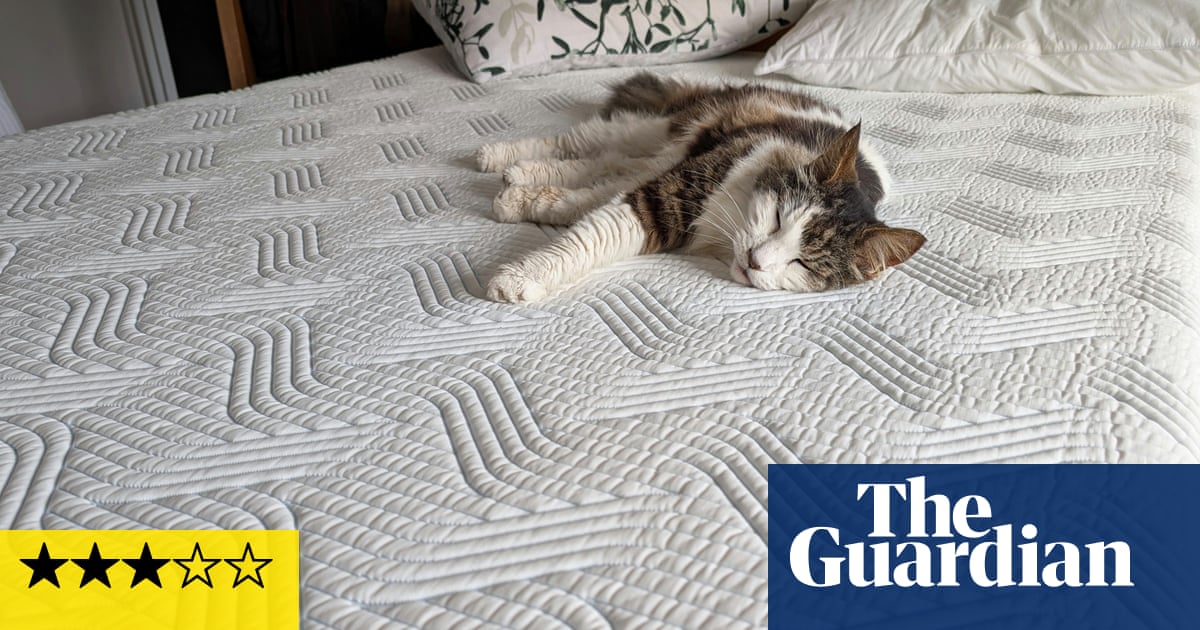I fear the Panda Hybrid Bamboo is playing games with me. When I first tried this mattress last year, it was among the firmest of all contenders in my mission to discover the best mattress. It was great-looking, easy to handle, and firm. Several months later, it’s great-looking, easy to handle, and … soft?
Not quite. But Panda’s mattress is a fine example of what happens to memory foam after you’ve slept on it for a few months. The initially solid sleeping surface adapts to your body, becoming softer and cosier. My tests with weights reassured me that the mattress was still supportive and not sagging, but it definitely wasn’t as firm as in those early weeks.
Being a hybrid mattress, the Panda Hybrid Bamboo contains springs as well as foam, although I’m not sure you’d know it. Hybrids cover a huge range, and this one’s very much at the “feels like all-foam” end. Here, I’ll explain why that makes it ideal for some sleepers – but not quite for me.
How I tested
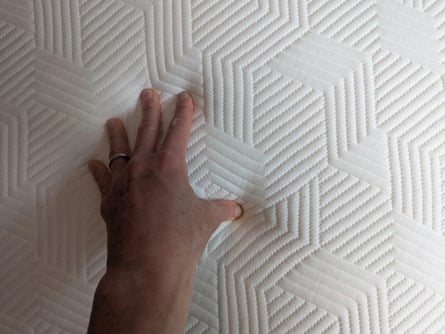
Bedding company Panda London sent me a double size Hybrid Bamboo mattress in autumn 2024. My husband, Alan, and I removed it from its bed-in-a-box wrapping and let it expand fully, then invited our family testing panel to mark out of 10 on firmness and comfort. We also ran lab-style experiments with heat pads, weights and wobbly cups of water to measure sinkage, motion isolation, heat retention and edge support. Alan and I slept on the Panda for a month in winter, then again during the much warmer nights of June.
What you need to know, from price to firmness
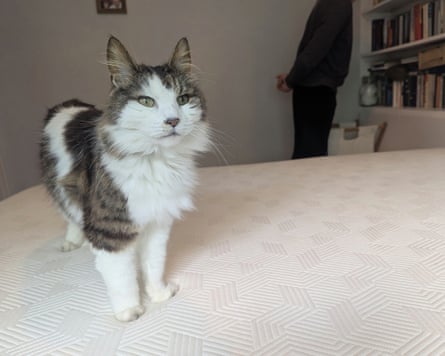
The Hybrid Bamboo is the cheaper of the two mattresses made by Panda London. It comes in nine sizes, including “small double”, and costs from £649 (UK single) to £1,050 (EU emperor) via £799 for a UK double. Those prices are roughly mid-range for a bed-in-a-box hybrid, but they’re much cheaper than Panda’s other mattress, the “orthopaedic grade” Hybrid Bamboo Pro, which costs from £950 to £1,750 and contains almost twice the number of springs.
Like all hybrid mattresses, the Hybrid Bamboo contains pocket springs plus layers of memory foam of various densities. The individually wrapped pocket springs have a barrel-shaped design, which means they offer more pushback where your body needs it, according to Panda. The mattress contains 612 springs in its largest size, somewhat fewer than firmer rivals such as the Origin Hybrid Pro, which has 5,700 springs in a double. Foam layers include an open-cell “BioCell” layer immediately beneath the surface, then a more dense “DualFlex” layer further down.
The mattress lives up to its name with infusions of bamboo in the fabric cover and open-cell foam. Panda claims this bamboo content is naturally antibacterial, moisture-wicking and deodorising, with the power to “prevent the natural heat retention of memory foam”.
The cream-coloured fabric cover is gorgeous, with a geometric pattern that looks almost art deco. You can unzip and remove the cover for washing in the machine when needed, but it comes off in one whole unit, like a shell. That makes it more tricky to zip back into place than most removable mattress covers. I managed it on my own, eventually.
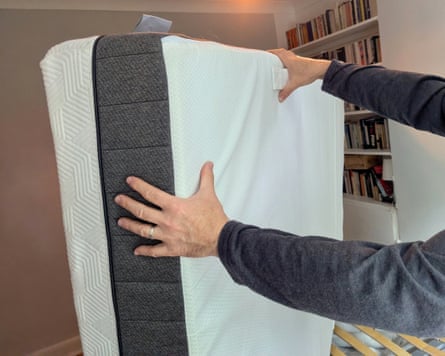
There are six layers in all, adding up to a depth of 25cm. That’s a nice medium depth, offering a balance of robustness and easy manoeuvrability, plus a snug fit for standard fitted sheets. Carry handles are hidden away on the underside of the mattress. As with most hybrids, the Panda is one-sided (only one side is designed to be slept on), so you don’t have to turn it. However, Panda recommends you rotate it 180 degrees every three to six months to prevent sagging.
Panda describes the Hybrid Bamboo as “medium firm” and gives it 6.5/10 for firmness. When it’s newly expanded, it feels significantly firmer than that – but it softens to its advertised tension after being slept on for a few weeks. When my family testing panel rated the Hybrid Bamboo a week after unwrapping, it scored 8/10 for firmness and sank a maximum of 19mm under 7.5kg of weight. Six months later, including two months of being slept on, it scored 6.8/10 and sank 34mm. This is within the expected settlement rate for memory foam.
You’ll need to take advantage of Panda’s 100-night free trial period before deciding whether this mattress is right for you.
Specifications
Type: hybrid
Firmness: advertised as medium firm, panel initially rated as 8/10, then 6.8/10
Depth: 25cm
Cover: remove to wash at 30C
Turn or rotate: rotate every six months
Trial period: 100 nights
Warranty: 10 years
Old mattress recycling: free
Sustainability credentials: foam is CertiPur approved; polyester content is made from recycled ocean bottles; will recycle old mattress
Delivery

The Panda Hybrid Bamboo was delivered to my door in standard bed-in-a-box manner: it was shrink-wrapped in the factory and then transported in a big cardboard box. Panda’s free shipping service promises more than most rivals, including delivery to any room of your choice and the removal of packaging. I opted to have the box left in my hallway.
The Hybrid Bamboo took longer than average to expand to full size after unwrapping. Panda says to wait eight hours before lying on it, but I’d add at least two days to that. If you try sleeping on the mattress any sooner, it will feel soft and uneven, and the chemical “off-gassing” smell is unlikely to help you snooze peacefully.
What we love

I was too hard on the Panda at first, because it was too hard on me. Along with my family, I found its sleeping surface unforgiving, especially for those of us who are small and sleep on our sides. Six months later, including at least two months of being slept on, the Panda Hybrid Bamboo turned into a much cosier mattress whose growing softness didn’t compromise its supportiveness.
I’d initially allocated sleep-testing duties to my dad, Don. He’s fit as a fiddle at 85 but found the Panda to be “hard on my joints”, so Alan and I stepped in for snoozing. We’d previously found our sleeping sweet spot on the firm Otty Original Hybrid, and welcomed the spongy but robust surface of the Panda Hybrid Bamboo. It felt too firm on the first night, but over the first few weeks of March, it yielded just enough for comfort when we slept on our sides, and we slept very well.
after newsletter promotion

As the weeks went by, Alan and I both noticed a distinct softening in the upper foam layer. I didn’t mind this at first, because it felt consistent and natural, unlike the slight central sagging I’d noticed in the Simba Hybrid Pro. Our sleeping bodies made dents in the surface overnight, but it puffed back to flatness within a few hours and offered strong pushback when we lay down.
The Hybrid Bamboo’s motion isolation is excellent, perhaps thanks to its high memory foam content. There’s no bounce to this mattress at all, so it does a great job of absorbing the movements of a restless partner – such as my husband and me.
Foam can make you overheat at night, since it tends to hold on to the warmth of your sleeping body, but the Panda did well here. It performed above average in my heat-retention tests and felt cosy without making either of us clammy. We tested it in February and June under very different weather conditions, and despite its foamy feel, it didn’t overheat us on the hot summer nights. I also like that its cover claims to be hypoallergenic, because on high pollen days (and nights), I need all the help I can get to curb my hay fever.
What we don’t love

It seems odd now that the Panda’s firmness was its biggest initial flaw for my family testing panel. By the end of the two months, it felt too soft for me and my husband to sleep on comfortably, and perfect for my dad. Sorry, Dad, it’s going to charity.
The softening of the Hybrid Bamboo’s upper layers is entirely to be expected, but it’s a distinctive quality of memory foam that won’t suit everyone. The spongy sensation can feel like you’re being hugged by a giant marshmallow, with no room for air to move. I also found myself worrying that I wasn’t being supported enough, and that affected my ability to sleep.
I disliked the way the edge gave way beneath me when I got in and out of bed. When you sit on the side of the Hybrid Bamboo, it doesn’t really support you at all. There’s a frame of dense memory foam around the mattress’s layers to help maintain its shape, but it just doesn’t seem to have the intended effect.
Sustainability

Panda’s sustainability efforts are generally good. The bamboo it uses in mattresses and other products is grown organically “without any fertilisers, pesticides or herbicides”, and the polyester in its vaguely described “durability layer” is made from “recycled ocean bottles”. It also uses 100% biodegradable “kraft paper” for its boxes, but there’s no word on the composition of the metres of thick soft plastic used to shrink-wrap the mattress for delivery.
Memory foam, made from high-viscosity polyurethane, is not a green material by any stretch. Panda does its best to limit the environmental impact of its foam, including CertiPur certification and donating bedding to young people transitioning out of homelessness.
The company says it designs its mattresses to last many years to prevent them from ending up in landfill. When I asked Panda for more detail on this “built to last” policy, it told me it randomly selects a few mattresses from its production line every six months for a “rigorous laboratory durability test” in conditions that mimic the moisture fluctuations of a real bed. “These stringent trials go far beyond standard industry checks,” Panda’s Natalie Cannavo told me. “They are integral to our quality assurance process and ensure that our 10-year guarantee is backed by evidence.”
In keeping with this landfill-avoidance strategy, Panda offers cheaper recycling than its rivals. It also makes its mattresses easier and cheaper to recycle than its rivals. Most mattress companies ask a fair whack to dispose of your mattress responsibly (Origin charges £54, for example), but Panda does it for free if you’re buying a mattress. If you’re not, the service costs £50. Panda will donate your old mattress to charity if it’s too good for recycling. Using this “Circle of Life Initiative” even gets you 20% off your next Panda purchase.
Panda Hybrid Bamboo: should I buy it?
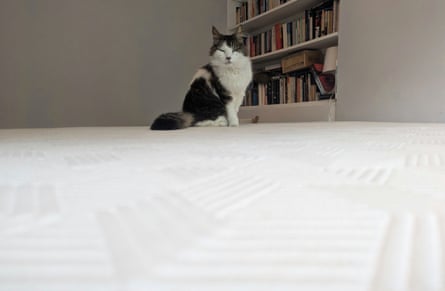
The Panda Hybrid Bamboo is a mid-price, mid-softness hybrid mattress whose cushioned surface provides good pressure relief for side sleepers and anyone who loves a cosy bed. Its springs are much less noticeable than its memory foam, which absorbs motion brilliantly and softens over time. On breathability, though, the Panda performs more like a pocket sprung mattress, so it may be a good choice if balmy nights drive you barmy.
Jane Hoskyn is a consumer journalist and WFH pioneer with three decades of experience in rearranging bookshelves and ‘testing’ coffee machines while deadlines loom. Her work has made her a low-key expert in all manner of consumables, from sports watches to solar panels. She would always rather be in the woods

 3 months ago
159
3 months ago
159











































